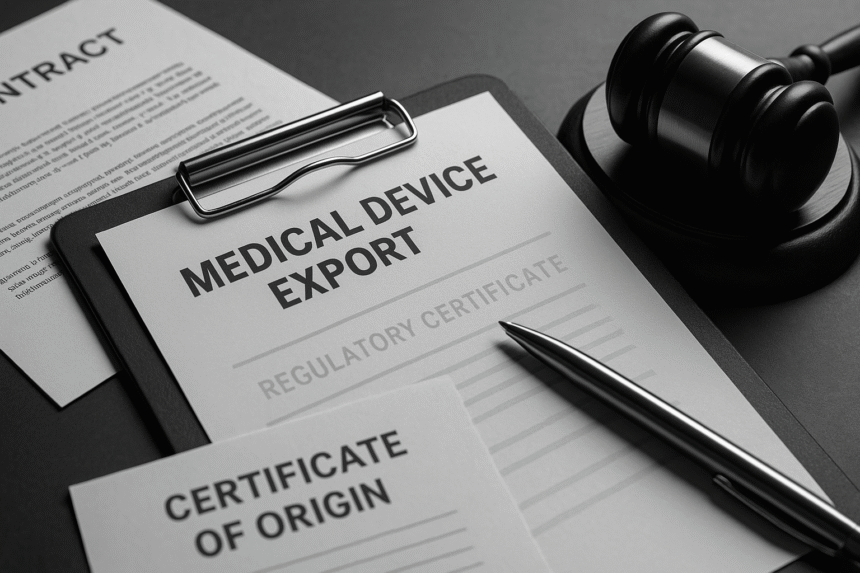10 Legal Documents You Need Before Exporting Medical Devices
Exporting medical devices is a huge opportunity—but it’s also heavily regulated. Missing even one key document can delay shipments, cause customs issues, or worse—result in fines or a full ban from the target market.
In this article, we’ll break down the 10 essential legal documents you need before exporting medical devices internationally. Whether you’re a manufacturer, distributor, or startup planning to go global, this list will help you protect your business and stay compliant.
Who This Is For / Why This List Matters
This guide is for:
- Medical device manufacturers entering international markets
- Exporters or distributors handling cross-border compliance
- Startup founders in the healthtech space
- Consultants or legal advisors working with regulated medical businesses
This list matters if:
- You’re launching exports for the first time
- You want to avoid customs clearance delays
- You’re entering high-regulation markets like the EU, US, GCC, or Asia
1. Regulatory Approval Certificate (or Free Sale Certificate)
Before exporting, you must prove the device is legally sold in its home market.
This is usually a Free Sale Certificate or Certificate of Market Authorization issued by your national regulator (e.g., FDA in the US, EDA in Egypt, SFDA in Saudi Arabia).
Why it matters: Importing countries want proof that the device is safe and approved somewhere else.
Tip: Always match the model and product name on the certificate with your shipping and packaging labels.
2. CE Marking or FDA Clearance (as applicable)
If exporting to the EU, a CE Mark shows that your device meets European safety and health standards.
For the US, the device must be FDA-cleared or approved under the correct classification.
Why it matters: Without this, you may face entry rejection, penalties, or loss of distributor partnerships.
Tip: Include the Declaration of Conformity along with your CE or FDA document.
3. Commercial Invoice
A legally required export document that includes:
- Seller and buyer information
- Product descriptions
- HS code
- Quantity and value
- Payment terms
Why it matters: Customs authorities use this to assess duties and verify the legitimacy of the transaction.
Mistake to avoid: Inaccurate pricing or mismatched HS codes can trigger audits.
4. Packing List
Lists each item included in the shipment, including:
- Unit weights and dimensions
- Serial or batch numbers
- Packaging type (box, crate, etc.)
Why it matters: Helps with customs inspections, inventory checks, and logistics.
Legal tip: Some countries may require this document to be signed and stamped.
5. Distributor or Agent Agreement
If you’re exporting via a local distributor, you need a clear legal agreement that defines:
- Exclusive/non-exclusive rights
- Marketing responsibilities
- Minimum order quantities
- Warranty and liability terms
Why it matters: Sets expectations and reduces risk of disputes or misrepresentation.
Add-on: Include IP clauses to prevent misuse of your brand.
6. Certificate of Origin
Issued by a chamber of commerce or relevant authority, this document shows the product’s country of manufacture.
Why it matters: It determines eligibility for preferential tariffs or trade agreements (e.g., GAFTA, EU trade deals).
Example: Exporting from Egypt to the UAE may benefit from tariff reduction with the right certificate.
7. Quality Management System Certificate (ISO 13485)
ISO 13485 certifies your QMS is aligned with international standards for medical devices.
Why it matters: Some markets require this as a pre-condition to import or registration.
Tip: Attach this to your regulatory submission or distributor onboarding pack.
8. Product Liability Insurance Policy
A legal protection covering claims if the exported device causes harm or fails to perform as advertised.
Why it matters: Many international distributors or hospital groups require this before signing contracts.
Include: Jurisdiction, coverage amounts, and product categories.
9. UDI / Labelling Compliance Document
Your device must meet the destination country’s labelling rules and UDI (Unique Device Identification) requirements.
Why it matters: Customs checks labels. If they don’t match the regulatory or language requirements, shipments may be rejected.
Tip: Keep a template or sample approved label in your document pack.
10. Export License (if applicable)
Some devices—especially those with wireless tech, software, or considered dual-use—may require an export license.
Why it matters: Export control violations can result in penalties or a ban.
Check: National export control rules and the destination country’s restrictions.
Mini Case Example: Delay Due to Labeling Mismatch
A startup in the UAE exported diagnostic kits to a GCC country. The product passed clinical validation and had MOH approval. But the shipment was held at customs because the Arabic label had a minor mistranslation of the usage instruction.
They lost two weeks and had to reprint boxes. Since then, they’ve made bilingual label review a legal checkpoint.
Quick Checklist: Legal Docs for Medical Device Export
Final Thoughts + CTA
Exporting medical devices requires more than just a quality product—it takes legal preparation. With the ten documents above, you can avoid costly mistakes and protect your supply chain.
Need help reviewing your legal documents before export? Book a legal consultation .



Leave a Reply